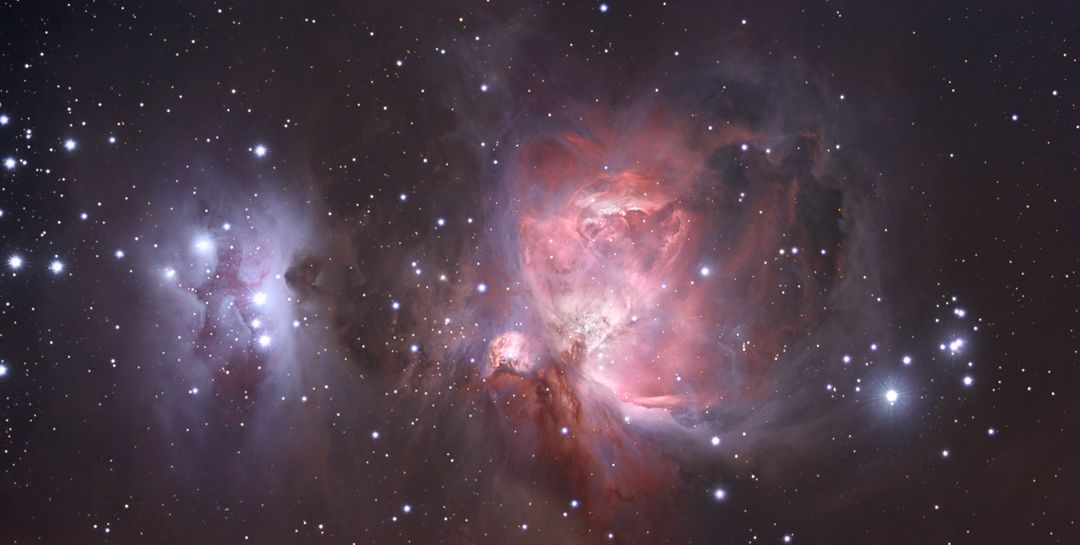Time Travel Research Center © 2005 Cetin BAL - GSM:+90 05366063183 - Turkey / Denizli
The Great Nebula in Orion (M42) and NGC 1977 (Running Man Nebula)

Please
click here or on image for a higher resolution vertical view
(693 x 1375).
Please
click here for the highest resolution
vertical view (990 x 1964).
Please
click here for a higher resolution
horizontal view (1375 x 693).
Please
click here for the highest resolution
horizontal view (1964 x 990).
Characteristics:
Magnitude: 5.0
Size: about 1.5 degrees (for the final mosaic)
Distance: 1600 light years
RA: 5h 35m
Dec: minus 5 degrees 35' 54"
Description:
This is my latest image of the M42 complex, representing a two frame mosaic
and about 6.5 hours of exposure time. The Great Orion Nebula is the
brightest nebula visible to the naked eye, forming the middle part of
the Hunter's sword in the famous constellation Orion. It is a
breathtaking view in even small telescopes, where tendrils of gas can be
appreciated even without the aid of special filters. The use of a UHC
filter improves contrast significantly and reveals a significant amount of
faint nebulosity during visual observation. The typical visual view in a
telescope is pale white to faint green, due to the human eye's poor color
response to low light (especially in the red, which is emitted by this
nebula due to excitation of hydrogen gas as a result of radiation from newly
formed stars). In this view, The Great Orion Nebula (M42) is on the right,
de Mairan's Nebula (M43) is just below center, and the Running Man Nebula (NGC
1977) is on the left, a beautiful reflection nebula that derives its blue
color from reflected light of nearby stars. Please be sure to check out the
links under the photo for higher resolution views.
Photographic Details:
Date: December 15 and
December 17, 2004.
Scope: Takahashi Sky 90 at
f4.5 with field flattener/focal reducer, on a Losmandy G11 mount.
Autoguider: STV with e-finder.
Camera: SXV-H9.
Filters: Ha (13nm bandpass),
L, R, G, B type II filter set, all from Astronomik.
Exposures (all unbinned):
December 15 (the right hand side of the mosaic): 22 x 4' luminance; 20 x
30" luminance; 6 x 4' each R, G, B; 20 x 30" each R, G, B; 6 x 5' Ha; 20 x
30" Ha. December 17 (the left hand side of the mosaic): 20 x 4' luminance;
6 x 4' each R and G, 8 x 4' B. Total exposure time about 6.5 hours.
Conditions: In a word-
glorious (except for the temperature, which was 18-20 degrees F on both
nights). I've never had transparency and seeing conditions like this. No
clouds. No wind. After the moon set, the sky was inky black, and the stars
hardly twinkled....
Post-processing: LHa:(LHa:R:G:B)- please see below for details. No
darks, flats, or bias frames required. Alignment, combining (min/max
excluded averaging), and DDP done in ImagesPlus. Levels, curves, and layer
mask adjustments in Photoshop. Processing this image required several
techniques, which were straightforward but time consuming. These included:
1) Making layer masks using the shorter 20 x 30" luminance, RGB, and Ha
exposures for the Trapezium region. The 30" Ha exposures were needed to
provide good definition of the Trapezium itself; 2) Sharpening using a
combination of high pass filtering (radius of only 2 pixels, using Overlay
mode in PS) and unsharp masking (amount 80% and radius 1.5) applied
selectively to certain regions. The image was quite smooth and permitted
sharpening without introducing too much noise; 3) The luminance channel was
comprised of L plus Ha, restricting the Ha contribution to about 50% opacity.
This LHa luminance component was combined with the RGB in Photoshop as
a standard luminosity layer (i.e., I did not use the technique of Luminance
Correction for this image, since there was reasonably good matching between
luminance signal and color). After boosting the color saturation of the RGB
component, a mild guassian blur was applied to the color layer, the image
was flattened (now representing an LHa:R:G:B layer), and it was then used as
color for another LHa luminance channel (this is a modification of a
technique developed by Rob Gendler). Thus, the final image is LHa:(LHa:R:G:B),
which resulted in good preservation of detail and color; 4) Registration of
the two frames was done in Registar, prior to mosaic construction.